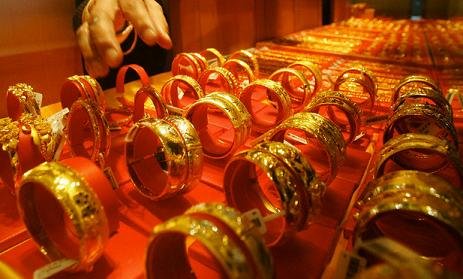By
Reuters
Reuters
Published
Sep 29, 2010
Sep 29, 2010
China set to take centre stage in gold market
By
Reuters
Reuters
Published
Sep 29, 2010
Sep 29, 2010
(Reuters) - The easing of restrictions on China's gold imports should boost its influence on global bullion trade as Chinese investors turn to the open market to satisfy their hunger for the metal, the World Gold Council said.
 Gold jewellery in a shop in China. Photo : Corbis |
Chinese gold demand is expected to show at least single digit percent growth this year at a time when high prices are curbing buying in other major physical markets like India, the WGC's Far East managing director Albert Cheng said on Tuesday.
This is likely to mean the shortfall between Chinese supply and demand, which stood at 144 tonnes last year according to figures produced by the WGC, increases even further.
"There is already a gap, and this gap will widen," Cheng said on the sidelines of the London Bullion Market Association conference in Berlin.
"The Chinese government... used to be afraid of too much gold being imported into the country, because that meant a drain of U.S. dollars. Now, this is nothing."
He said moves announced in August by the People's Bank of China to allow more Chinese banks to export and import gold mean the shortfall is increasingly likely to be met by gold bought on the global market, rather than domestically.
Chinese demand is the key driving force for a number of key commodities, such as copper, but its status as the world's biggest gold producer as well as its second biggest consumer has meant its impact on the wider gold market has been muted.
This could be changing, said the WGC, a gold industry lobby group.
"The answer to the question of why gold is not like copper, or iron ore, with (China representing) a big percentage (of total demand)... is that in the past few years the access to gold has still been limited," said Cheng.
"Going forward, with these measures, access will be much easier for investors who want it. In the next few years, you will see the real gold demand for China."
"I think the trend will follow other, base metals, because there will be no regulatory barrier for people who want to have gold," he said.
NO SOFTENING OF Jewelry DEMAND
World physical gold demand, particularly for jewelry, has softened in recent years as the global economic slowdown and an investment-driven rise in prices has put off buyers. Spot gold
hit a record $1,300 an ounce on Monday.
India, which alone accounts for around a quarter of global demand, has been particularly hard-hit. Indian gold imports fell to their lowest level in more than a decade last year.
Jewelry consumers in the United States and Europe have also been put off by a lack of consumer confidence that has affected a string of luxury goods. But the strength of Chinese growth is reassuring the country's jewelry buyers, Cheng said.
"The (economic) growth rate in the last few years has not dropped," he said. "That has a very good effect on jewelry demand. Jewelry demand has not come down in the last few years, it has seen a 5-10 percent increase year-by-year."
He expects this growth rate to be maintained this year. "Over and above all of the emotional reasons for buying jewelry, in China it is also purchased as a store of wealth."
However, he said demand for products like physically backed exchange-traded funds remained more muted than in Western countries, as Chinese buyers were more culturally acclimatized to buying physical gold in the form of bars or jewelry.
"In the U.S., there is a need for gold products which give investors an exposure to gold in a cost-efficient and easy way, because physical gold is not widely available," he said.
"In China physical gold is widely available," he said. "Asians have strong appetite for physical gold -- they like to bring it home."
(Reporting by Jan Harvey; Editing by Anthony Barker)
© Thomson Reuters 2024 All rights reserved.

























